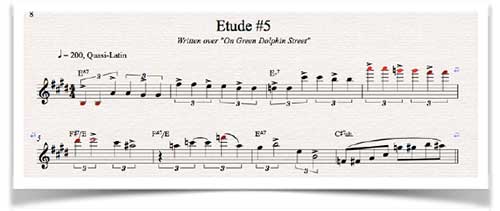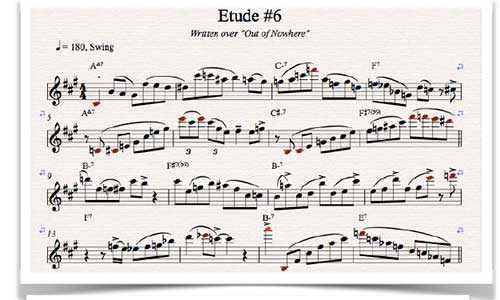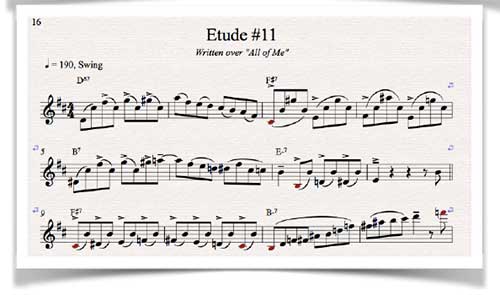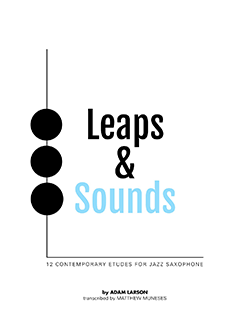Using Bigger Intervals for Better Solos

The main concepts that I wanted to address in writing my first book Leaps & Sounds: 12 Contemporary Etudes for Jazz Saxophone, were integration of large intervals into improvising, voice leading and harmonic content. When Doron (the owner of BestSaxophoneWebsiteEver.com), asked me to write a short article to expand a bit on these concepts, I went back through my book to find a few specific examples that I could refer to elaborate.
Before we get there, it should be said that anyone looking to have success applying any of the topics here in their own soloing should be practicing intervals – diatonic and chromatic – through the octave at a minimum. Additionally, it’s imperative to practice these intervals in multiple directions, as well as arpeggios in the same fashion.
Battling Basics-Burnout
At a certain point in my playing I started to become bored at the thought of practicing major scales, simply because I had spent hours of time on each of them and I felt burnt out. Whenever this happens for me, I try to find a way to make whatever has become mundane and make it intriguing again.
This is one of the greatest things about being a creative musician – you get to put your own creativity on trial as often as you like! I’m firmly of the belief that if you are bored in the practice room, you are wasting time and not pushing yourself hard enough.
I think that the successes and failures I have had as an improvising musician are directly proportional to the number of options (or not), I have readily available to attack a certain situation. Those options often boil down to the lens that I see the information through. If you have ever thought to yourself, “wow, I play the same thing over this chord”, or, “I always play eighth notes”, it’s probably less indicative of you not having the skill to play, and more so the inability to play the information in a fresh way.
Into Action
The exercises referenced below can be downloaded in a more readable, printable PDF format here.
So, let’s take the major scale and make it really fresh. Chances are strong that if you started saxophone in fifth grade like I did, you have been playing the major scale in an ascending and descending fashion for a very long time. Check out Figure 1 and you will see exactly the latter; a C major scale descending one octave.
Looking at Figure1a, you will see:
- The exact same C major scale, but…
- This time as the pitches descend (C to B to A to G, etc), the notes are actually ascending by diatonic seventh.

In Figure 1a, ledger line G on saxophone is where it becomes most practical to make a register adjustment to continue on with the scale. You could of course play the F natural that follows ledger line G, as an altissimo F, but for the sake of argument, let us assume most people have a better sounding F in the staff, than altissimo F.
If we assume that, then the next note descending in the C major scale after G, is F and we will play that as it’s written in Figure 1a, on the first space in the staff. You can see that the construction of the scale continues with each note being a diatonic seventh above the previous note, until you arrive at the tonic again on altissimo C in the end of Figure 1a. If you don’t have an altissimo C that speaks clearly just yet, just play the lowest available C that you have.
This is true of any key that you might apply this method to. If you don’t have it high, play it low, is the general idea.
Now, if you’re like me and you’ve spent a lot of time practicing the modes of major diatonic to each key, you are in for a great workout because you can apply this exact logic to all the modes of the key, for all twelve keys of major, melodic and harmonic minor. This is a considerable amount of work, but it should make all of those scales a lot more engaging to practice again.
From Exercise to Art
So, let’s talk about the practicality of using scales like those constructed in Figure 1a in an improvisational setting. If you’ve picked up your horn while reading this article and tried it, you probably already know that unless the tempo is kind, it’s going to be exceedingly difficult to apply the scales as written if nothing else because of the sheer difficulty of the range.
If you look at Figure 2, though, you can see that it’s the same series of notes but arranged so that they all fall within a three octave range. The construction here from the tonic is to play the next note up a diatonic seventh, followed by a descending scale step; repeating this pattern until you reach the tonic again at the top of the scale.
You can make this even more user-friendly by adapting the pattern you see for Figure 2a, which is:
- Up a diatonic seventh
- Down two scale steps, until you reach the tonic.
Now, let’s look at a few examples from my book where I’ve made a conscious choice to include some of these concepts into the etude.
In Etude #5, written over “On Green Dolphin Street”, the first four measures are exactly what I’ve just described from the previous paragraph. The only difference is that I’ve started to play the notes of the E major scale:
- Starting on the fifth, which starts my idea away from the root of the harmony (typically being played by at least one other instrument), and…
- Also allows me to get to the next destination with smooth voice-leading, when I arrive at…
- The seventh of E-7 (D natural), coming from the seventh of E major (D sharp), on the downbeat of measure three.
- The pattern then continues by playing the notes of E dorian, descending until…
- I arrive at my next destination, with is the thirteenth of F#7 on the downbeat of measure five.

Now take a look at the excerpt of Etude #6, written over “Out of Nowhere”. The first two bars follow a similar line of thought as the previous example, but it is more closely related to the Figure 2a.

The general construction of the opening line is ascending diatonic seventh, down two scale steps. Yes, there are some chromatic passing tones that occur in measure two, but with the exception of those instances (D# on the downbeat, C natural on beat two and A# on the “+” of 2), the first two measures are:
- An A major scale starting on the third, following the formula of ascending diatonic seventh (in this case diatonic to A
- Down to two scale steps, until it reaches the tonic on beat 4 in measure two.
Departing from the scale idea for a moment, take a look at measures 11 and 12. The guiding interval through this section is diatonic 7th within the chord, and typically the connective tissue is a scale step.
- Beat 1 to the “+” of 1 is a seventh
- Beat 2 to beat 3 is a seventh with a scale step (D natural) connecting the two.
- Similarly, the “+” of 3 to the “+” of 4 is a seventh, and so on.
Last thing to check out on this excerpt are the last two measures. In measure 15 you have an extreme example of large interval integration with an altissimo A followed by a low B. Both are chord tones and the notes that follow the low B are also all either chord tones or extensions to the chord written.
Further, the intervallic relationship between the next three notes after the altissimo A, is ascending diatonic fifth.
The use of intervals large and small is very present throughout this book, in addition to the concept we’ve discussed thus far pertaining to scale construction. The final excerpt will examine intervallic relationships in a slightly different way.
In this excerpt from Etude #11, written over “All of Me”, my goal was to flesh out each individual chord as much as I could in one measure as well as connecting the motif from one measure to the next. When I think about connecting notes within a measure and then connecting measures within a phrase, I immediately think about common tones and/or “pedals”, that give the line something to reference.

In the first measure, the common tone is the note C sharp, as it is played three times. The etude…
- opens with an ascending diatonic seventh and then…
- The top of the phrase slowly walks to what I’m calling the destination of that first idea –
- an A natural on the downbeat of measure two, which is the fifth – and also a chord tone.
Within the first measure you hear the seventh of the chord in relationship to the root, which helps establish the key center.
Measures three and four use a very similar motif and in measure three.
- It starts on the fifth of the chord on the downbeat and…
- continues with the seventh on beat three.
Measure four continues the motif but: starts at the root and on beat four is the 7th. All of these are strong chord tones, which is imperative for good voice leading.
Measures five and six continue in a similar fashion and the motif:
- Begins on the third of the chord…
- with the destination once again being the note A natural…
- this time on the “+” on 4 in measure five.
When A natural was previously the destination (measure 2; downbeat), it was a chord tone to D major – the fifth.
Against this new harmonic backdrop of B7, it is now the seventh, but both lines arrived at the same place, which helps further the idea of the motif.
Measure 7 is the first time where the motif releases, yet it follows a similar logic, with:
- The pitch B, played in the lower and middle octaves with notes of the scale crawling towards…
- The destination of E on the downbeat of measure 8.
The scheme of the motif for measures 1-8 follows a very familiar pattern for motivic development; tell them something, tell them something again, tell them one more time, tell them something different. I decided to start back in on the next phrase with a similar type of motif, but by measure 10, I’ve departed into a new idea.
In Conclusion
Hopefully this article provides some insights into the way that these etudes were conceived and for what purpose. Please feel free to reach out with any further questions via the contact page on my website!
Adam Larson’s new book “Leaps & Sounds: 12 Contemporary Etudes for Jazz Saxophone”, is now available here:
- Treble Clef E-book: http://adamlarsonjazz.com/store/49758493
- Bass Clef E-book: http://adamlarsonjazz.com/store/49758757
- Physical copy: http://adamlarsonjazz.com/store/49265464
For more information or to contact Adam directly, please visit www.adamlarsonjazz.com







September 4, 2018 @ 12:39 pm
the pdf print format is not friendly for seniors with reading glasses
September 8, 2018 @ 11:06 am
Hello Govert, sorry that the sheet music is a bit small. Maybe there is a setting on your printer that will let you print it at a larger size?
Or if you are reading it on your computer, you should be able to zoom in so that the notes are larger.
I hope that helps!
Saxophonist Chris Bittner's Musical Journey, Plus a Tritone Vocabulary and Implied Harmony Exercise » Best. Saxophone. Website. Ever.
April 22, 2020 @ 11:42 pm
[…] think Adam Larson is someone who has a good understanding of the music business and how to maneuver throughout your […]